Mobility for Grapplers

When looking to excel in grappling sports, including Brazilian Jiu-Jitsu, Judo and wrestling, strength and endurance are the two most common areas athletes focus on. While the physical demands of grappling require the participant to be strong and have endurance, these are not the only things that are required. Skill work is above all the most important. Without the proper techniques, you could be the strongest athlete in the world and get dominated by someone with higher skill. Strength will not improve your technique; it will only make you stronger through the range of motion required to complete a given skill. Grappling places the body in some very strange positions that require the athlete to have proper mobility and strength through a full range of motion.
Grappling presents a problem. Over time, it will lead to muscle imbalances, mobility restrictions, and postural misalignment. Grappling will cause restrictions in the same areas that are required to complete necessary skill work. With the large amount of contact that takes place, injuries are going to happen. However, a large amount of the non-contact injuries can be avoided.
Injuries play a role in mobility issues. During an injury, the body develops compensation patterns and restrictions. Even after an injury is healed, unless the mobility and movement patterns are addressed, compensation patterns will remain. This can result in re-injury of the same body part or another body part that is overcompensating for what was the original injury. To improve grappling skills, the athlete must be healthy enough to practice, and injury that requires the athlete to miss practice will do very little to improve grappling technique. Let’s take a look at some of the common traits all grapplers have, what mobility can do for grapplers, how to identify mobility issues, specific areas of restriction that are common in grapplers, and how to incorporate a mobility routine.
Common Traits of Grapplers
Grapplers normally have a high strength to weight ratio. Of course, there are always exceptions to the rule. For the most part, grapplers are strong relative to their weight. Grappling can be viewed as a form of resistance training. The external resistance is your opponent’s body. Some grapplers may have average numbers in the weight room, but when they grab your wrist, you can’t break their grip. Grapplers take the strength developed from their sport and understand how to use it. It is one thing to be strong and another to be strong and know how to use it on the mat. You may find some grapplers who are very strong but lack mobility. Others are great athletes but lack the necessary technical skill. Regardless of what category athletes fall into, corrective work will help them. Grapplers are notorious for pushing themselves until exhaustion, and fighting through pain. They will often go to extremes in their training to get ready for a tournament without understanding the effects it has on their body. Sometimes this can cause injury later in the season, sickness, or poor performance. A movement and mobility routine will help them recover and reduce unnecessary injuries.
What Does Mobility Do For the Grappler?
For the grappler, improving mobility serves multiple purposes. First, improved mobility will reduce injury. Having a restriction in a joint will limit range of motion. During a match, the body can be placed in some very strange positions. Not having the proper mobility will place unnecessary stress on the joint and the surrounding tissues. Second, mobility will improve performance. Gaining new range of motion in a joint will allow the athlete to finish takedowns or attempt a submission they could not get to if there was a restriction. In Brazilian Jiu-Jitsu, lacking mobility in the hips will make finishing sweeps difficult. Most submissions (such as triangles, arm bars, and so forth) require a large amount of mobility. All require movement of the hips. Third, mobility improves recovery. The better an athlete can recover, the more they can push the next day. If the athlete is so beat up from a previous training session, their performance will suffer. Recovery affects sleep, stress, nutrition, and mobility. Every aspect of recovery should be addressed in order to place the body in the best possible environment to repair.
Movements Tell All
Depending on how many athletes you are working with, it is difficult to determine movement restrictions at first glance during practice. When an athlete has a difficult time completing a technique or drill that is shown by the instructor, it is difficult to determine if the issue is a restriction or a skill issue. Not understanding the technique will make completing it difficult. This is also true for having a movement restriction. The double leg takedown is a great example. If the athlete does not have the mobility in the hips, knees, or ankles, performing a proper double leg will be very difficult. Likewise, if they lack the proper technique, performing a proper double leg will be challenging. For new athletes, it could be a combination of both.
Identifying specific areas of restriction in movement patterns can be determined by a few methods. There are two schools of thought here. Some experts recommend looking at specific movements like the squat and deadlift to determine areas of restriction. Another group uses a screen or assessment such as the Functional Movement Screen (FMS). The FMS will give the coach or athlete a score, and based on the score, it will show if an athlete has an increased risk of injury and specific movement patterns that are restricted. Another bonus of the FMS is by having a score it allows the coach and athlete to see if the current program they are on is or is not working. If you have access to someone trained in the FMS, my suggestion would be to complete a FMS screen at the start of the season, middle of the season, and one before the off season. For Brazilian Jiu-Jitsu and Judo competitors their season can go all year. In that case, you can get an assessment two to three times a year. For athletes or coaches who want a quick assessment, weight room sessions can tell a lot. By paying attention to body positioning during the squats, deadlifts, and overhead pressing, the coach or athlete can gain insight into mobility issues.
In the weight room, movement pattern and mobility issues show up frequently. We live in a society where many sit for eight hours a day working on a computer. Students spend hours sitting in a classroom all day. Most of the athletes in Brazilian Jiu-Jitsu or Judo do it for recreation. They attend class after work to learn something and get some exercise. Others are in law enforcement and use it for self-defense. The rest are competitors. Even many of the high level competitors have jobs. The way you sit or stand each and every day affects your movement.
Watch athletes in the weight room try to squat. You can see some very interesting versions of a squat. Then watch a child squat or perform a deadlift. It’s perfect. Did the child’s parents teach them how to squat? Or is squatting and picking stuff off the ground a fundamental movement that everyone should be able to do? At that young age, compensation patterns have not yet been developed. Years of sitting, poor posture, injures, and grappling change these movement patterns. Patterns of compensation now become normal. After injuries the injury may be healed, but the movement pattern was never fully restored.
Specific Areas for Grapplers
Grappling sports will cause movement and mobility issues especially if done for a long period of time. The longer an athlete trains, the longer their body has been in compromised positions. Look at any wrestler. They may shoot hundreds of double legs a practice, sometimes only using one side. This alone will develop asymmetries. Now let’s add in shooting a double leg and someone sprawling on top of you driving your neck into the mat. This is a very uncomfortable position. A Brazilian Jiu-Jitsu athlete will normally favor one side, always doing armbars on the right and hip bump sweep on the left are two examples. Asymmetries can lead to an increase in injury.
Many of the positions in grappling place the athlete in a rounded position. Shoulders rounded forward. Proper spinal position is shoulders back. Grapplers will use the head for a control point, cross face, or snap down for a takedown resulting in a rounded position. The rounded position is not as strong as neutral spine making it easier to sweep or take down your opponent. This can happen hundreds of times during practice. For grapplers the most important areas are the thoracic spine, hips, knees, ankles and elbows.
Thoracic spine
The thoracic spine makes up the middle segment of the vertebral column between the cervical and lumbar vertebrae. Without proper mobility in the thoracic spine, athletes can experience pain in the low back and shoulders. For grapplers, having pain and stiffness in the thoracic spine will make it very difficult to complete some techniques. Shoulder mobility is huge in Brazilian Jiu-Jitsu. Without good range of motion in the shoulders some submissions will result in tapping out. Tapping out happens not from the actual technique but from pain caused by a lack of range of motion when the submission is applied. Thoracic mobility will also improve your endurance. Having more relaxed muscles in the spine allow for more movement with the breath.
Hips
Having good hips is critical for a grappler. Almost every technique requires hip mobility. For the wrestler, sprawling and shooting require strong and mobile hips. For the Brazilian Jiu-Jitsu athlete, finishing a triangle from the guard or arm bar will be difficult without proper hip mobility. New students find it difficult to complete many of the required techniques as a result of poor mobility. Poor hip alignment and mobility can cause injuries in other areas. Often knee and low back pain stems from the hip.
Knees
The longer you spend grappling, the higher your chances are of suffering some type of knee issue. Knee issues can come from overtraining, mobility issues in other areas of the body, fast cutting movements, and contact. Wrestlers who like to shoot a lot of double legs are constantly driving their knee into the ground. Patella tendonitis, also known as jumper’s knee, is common to see in wrestlers. For the Brazilian Jiu-Jitsu athlete, passing the guard requires a lot of side-to-side movement. To pass a high level guard, passes must be strung together forcing the athlete to cut one way then the other. While the guard passer is trying to cut back and forth the guard player is fighting like mad to sweep or submit. Poor knee mobility and stability can result in injury or giving up unnecessary points. For the more experienced Brazilian Jiu-Jitsu athletes, knee bars start to come into play. Similar to an armbar, the less mobile your knees are, the faster you will have to tap.
Ankles and Elbows
Ankles and elbows get overlooked. Poor ankle mobility makes it very difficult to perform any squat-type movement. Standing up to try and open someone’s guard requires a movement that is very similar to a squat. For wrestlers, shooting double legs with poor ankle mobility is very difficult.
Most Brazilian Jiu-Jitsu athletes have a hard time extending their arms all the way. Years of training play a toll. Wrestlers and Brazilian Jiu-Jitsu athletes find themselves posting their hand out to stop a takedown or a sweep. Posting the arm while someone is applying force against you can take a toll on the elbow. Many grapplers experience an elbow tweak at some point while training.
Corrective Work: When and How Much
Coaches may find it difficult to incorporate mobility work into their athletes’ schedules. Some coaches work with a large number of athletes and have limited time each day with them. In Brazilian Jiu-Jitsu, the majority of participants train for fun. High school and college athletes have to balance school and practice.
Mobility is important for anyone participating in a grappling sport. A common misunderstanding about mobility is how much time it takes. Mobility does not have to take up hours. A large amount of progress can be made with 15-20 minutes a day.
It is important to understand when mobility work should be done. On non- training days, mobility training can be done at anytime. During training days, a mobility program can be implemented. One way to implement mobility work is start a training session with smashing movements like foam rolling or soft tissue work with lacrosse balls. After a training session, add in stretching type movements such as hip distractions with a jump stretch band. Something as simple as 10 minutes before and 10 minutes after training is enough to produce results.
On weight training days, the athlete can warm up with smashing movements using a foam roller and/or lacrosse balls. In between sets, corrective work can be done. For example, if it’s a squat day and an athlete has tight hips, in between each set of squats instead of resting perform some active straight leg raises or banded hip stretches. This serves two purposes. First, it provides active rest and second, it gets their corrective work in without adding any extra time to the workout.
Mobility and corrective work make for a great recovery day. Grapplers are constantly pushing themselves. Following a hard training session a simple 15-30 minute mobility and corrective exercise routine will improve recovery.
Sample Mobility Routine Before Training
Start with a foam roller. For some grapplers, a foam roller may not be enough to start breaking up the restricted tissues. In this case, use a PVC pipe or double lacrosse balls. For two to three minutes, foam roll the following areas:
• Thoracic spine
• Latissimus Dorsi
• Lumbar Spine
• Quadriceps
• Hamstrings
• Calves
Next, perform 20 to 30 bodyweight hip hinges using strict form.
Sample Mobility Routine After Training
After your training session, grab a jump stretch band and attach it to something secure. Perform each exercise for two to five minutes each side:
Hip Extension Overhead shoulder with external rotation Active Straight Leg Raise
Sample Mobility Routine for Strength and Conditioning sessions
Start by foam rolling the following areas for two to three minutes: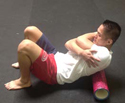
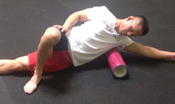
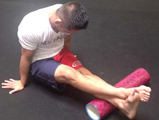
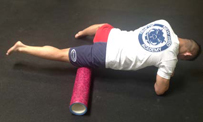
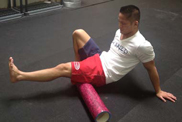
During the workout, match your mobility to the main movement of the day. Instead of resting between sets, spend that time doing mobility work between sets one to two minutes per side, depending on how much rest time you are allowed.
Squat Day/Deadlift Day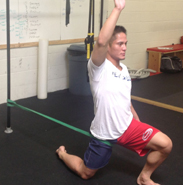
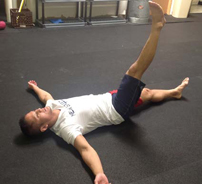
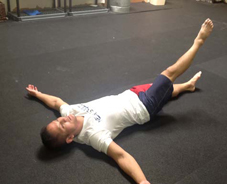
Grappling sports require athletes to push themselves mentally and physically. Most grapplers are extremely hard workers willing to push themselves until they can’t push anymore. Very few grapplers spend the time on mobility and corrective work. If grapplers put as much effort into mobility and corrective work as they did skill and conditioning, they would have longer and healthier careers. In order to improve in any sport, you must be healthy enough to participate. No one gets better on the sidelines. Making mobility and corrective work part of your training program will reduce your injury risk and keep you grappling for a long time.
Grappling presents a problem. Over time, it will lead to muscle imbalances, mobility restrictions, and postural misalignment. Grappling will cause restrictions in the same areas that are required to complete necessary skill work. With the large amount of contact that takes place, injuries are going to happen. However, a large amount of the non-contact injuries can be avoided.
Injuries play a role in mobility issues. During an injury, the body develops compensation patterns and restrictions. Even after an injury is healed, unless the mobility and movement patterns are addressed, compensation patterns will remain. This can result in re-injury of the same body part or another body part that is overcompensating for what was the original injury. To improve grappling skills, the athlete must be healthy enough to practice, and injury that requires the athlete to miss practice will do very little to improve grappling technique. Let’s take a look at some of the common traits all grapplers have, what mobility can do for grapplers, how to identify mobility issues, specific areas of restriction that are common in grapplers, and how to incorporate a mobility routine.
Common Traits of Grapplers
Grapplers normally have a high strength to weight ratio. Of course, there are always exceptions to the rule. For the most part, grapplers are strong relative to their weight. Grappling can be viewed as a form of resistance training. The external resistance is your opponent’s body. Some grapplers may have average numbers in the weight room, but when they grab your wrist, you can’t break their grip. Grapplers take the strength developed from their sport and understand how to use it. It is one thing to be strong and another to be strong and know how to use it on the mat. You may find some grapplers who are very strong but lack mobility. Others are great athletes but lack the necessary technical skill. Regardless of what category athletes fall into, corrective work will help them. Grapplers are notorious for pushing themselves until exhaustion, and fighting through pain. They will often go to extremes in their training to get ready for a tournament without understanding the effects it has on their body. Sometimes this can cause injury later in the season, sickness, or poor performance. A movement and mobility routine will help them recover and reduce unnecessary injuries.
What Does Mobility Do For the Grappler?
For the grappler, improving mobility serves multiple purposes. First, improved mobility will reduce injury. Having a restriction in a joint will limit range of motion. During a match, the body can be placed in some very strange positions. Not having the proper mobility will place unnecessary stress on the joint and the surrounding tissues. Second, mobility will improve performance. Gaining new range of motion in a joint will allow the athlete to finish takedowns or attempt a submission they could not get to if there was a restriction. In Brazilian Jiu-Jitsu, lacking mobility in the hips will make finishing sweeps difficult. Most submissions (such as triangles, arm bars, and so forth) require a large amount of mobility. All require movement of the hips. Third, mobility improves recovery. The better an athlete can recover, the more they can push the next day. If the athlete is so beat up from a previous training session, their performance will suffer. Recovery affects sleep, stress, nutrition, and mobility. Every aspect of recovery should be addressed in order to place the body in the best possible environment to repair.
Movements Tell All
Depending on how many athletes you are working with, it is difficult to determine movement restrictions at first glance during practice. When an athlete has a difficult time completing a technique or drill that is shown by the instructor, it is difficult to determine if the issue is a restriction or a skill issue. Not understanding the technique will make completing it difficult. This is also true for having a movement restriction. The double leg takedown is a great example. If the athlete does not have the mobility in the hips, knees, or ankles, performing a proper double leg will be very difficult. Likewise, if they lack the proper technique, performing a proper double leg will be challenging. For new athletes, it could be a combination of both.
Identifying specific areas of restriction in movement patterns can be determined by a few methods. There are two schools of thought here. Some experts recommend looking at specific movements like the squat and deadlift to determine areas of restriction. Another group uses a screen or assessment such as the Functional Movement Screen (FMS). The FMS will give the coach or athlete a score, and based on the score, it will show if an athlete has an increased risk of injury and specific movement patterns that are restricted. Another bonus of the FMS is by having a score it allows the coach and athlete to see if the current program they are on is or is not working. If you have access to someone trained in the FMS, my suggestion would be to complete a FMS screen at the start of the season, middle of the season, and one before the off season. For Brazilian Jiu-Jitsu and Judo competitors their season can go all year. In that case, you can get an assessment two to three times a year. For athletes or coaches who want a quick assessment, weight room sessions can tell a lot. By paying attention to body positioning during the squats, deadlifts, and overhead pressing, the coach or athlete can gain insight into mobility issues.
In the weight room, movement pattern and mobility issues show up frequently. We live in a society where many sit for eight hours a day working on a computer. Students spend hours sitting in a classroom all day. Most of the athletes in Brazilian Jiu-Jitsu or Judo do it for recreation. They attend class after work to learn something and get some exercise. Others are in law enforcement and use it for self-defense. The rest are competitors. Even many of the high level competitors have jobs. The way you sit or stand each and every day affects your movement.
Watch athletes in the weight room try to squat. You can see some very interesting versions of a squat. Then watch a child squat or perform a deadlift. It’s perfect. Did the child’s parents teach them how to squat? Or is squatting and picking stuff off the ground a fundamental movement that everyone should be able to do? At that young age, compensation patterns have not yet been developed. Years of sitting, poor posture, injures, and grappling change these movement patterns. Patterns of compensation now become normal. After injuries the injury may be healed, but the movement pattern was never fully restored.
Specific Areas for Grapplers
Grappling sports will cause movement and mobility issues especially if done for a long period of time. The longer an athlete trains, the longer their body has been in compromised positions. Look at any wrestler. They may shoot hundreds of double legs a practice, sometimes only using one side. This alone will develop asymmetries. Now let’s add in shooting a double leg and someone sprawling on top of you driving your neck into the mat. This is a very uncomfortable position. A Brazilian Jiu-Jitsu athlete will normally favor one side, always doing armbars on the right and hip bump sweep on the left are two examples. Asymmetries can lead to an increase in injury.
Many of the positions in grappling place the athlete in a rounded position. Shoulders rounded forward. Proper spinal position is shoulders back. Grapplers will use the head for a control point, cross face, or snap down for a takedown resulting in a rounded position. The rounded position is not as strong as neutral spine making it easier to sweep or take down your opponent. This can happen hundreds of times during practice. For grapplers the most important areas are the thoracic spine, hips, knees, ankles and elbows.
Thoracic spine
The thoracic spine makes up the middle segment of the vertebral column between the cervical and lumbar vertebrae. Without proper mobility in the thoracic spine, athletes can experience pain in the low back and shoulders. For grapplers, having pain and stiffness in the thoracic spine will make it very difficult to complete some techniques. Shoulder mobility is huge in Brazilian Jiu-Jitsu. Without good range of motion in the shoulders some submissions will result in tapping out. Tapping out happens not from the actual technique but from pain caused by a lack of range of motion when the submission is applied. Thoracic mobility will also improve your endurance. Having more relaxed muscles in the spine allow for more movement with the breath.
Hips
Having good hips is critical for a grappler. Almost every technique requires hip mobility. For the wrestler, sprawling and shooting require strong and mobile hips. For the Brazilian Jiu-Jitsu athlete, finishing a triangle from the guard or arm bar will be difficult without proper hip mobility. New students find it difficult to complete many of the required techniques as a result of poor mobility. Poor hip alignment and mobility can cause injuries in other areas. Often knee and low back pain stems from the hip.
Knees
The longer you spend grappling, the higher your chances are of suffering some type of knee issue. Knee issues can come from overtraining, mobility issues in other areas of the body, fast cutting movements, and contact. Wrestlers who like to shoot a lot of double legs are constantly driving their knee into the ground. Patella tendonitis, also known as jumper’s knee, is common to see in wrestlers. For the Brazilian Jiu-Jitsu athlete, passing the guard requires a lot of side-to-side movement. To pass a high level guard, passes must be strung together forcing the athlete to cut one way then the other. While the guard passer is trying to cut back and forth the guard player is fighting like mad to sweep or submit. Poor knee mobility and stability can result in injury or giving up unnecessary points. For the more experienced Brazilian Jiu-Jitsu athletes, knee bars start to come into play. Similar to an armbar, the less mobile your knees are, the faster you will have to tap.
Ankles and Elbows
Ankles and elbows get overlooked. Poor ankle mobility makes it very difficult to perform any squat-type movement. Standing up to try and open someone’s guard requires a movement that is very similar to a squat. For wrestlers, shooting double legs with poor ankle mobility is very difficult.
Most Brazilian Jiu-Jitsu athletes have a hard time extending their arms all the way. Years of training play a toll. Wrestlers and Brazilian Jiu-Jitsu athletes find themselves posting their hand out to stop a takedown or a sweep. Posting the arm while someone is applying force against you can take a toll on the elbow. Many grapplers experience an elbow tweak at some point while training.
Corrective Work: When and How Much
Coaches may find it difficult to incorporate mobility work into their athletes’ schedules. Some coaches work with a large number of athletes and have limited time each day with them. In Brazilian Jiu-Jitsu, the majority of participants train for fun. High school and college athletes have to balance school and practice.
Mobility is important for anyone participating in a grappling sport. A common misunderstanding about mobility is how much time it takes. Mobility does not have to take up hours. A large amount of progress can be made with 15-20 minutes a day.
It is important to understand when mobility work should be done. On non- training days, mobility training can be done at anytime. During training days, a mobility program can be implemented. One way to implement mobility work is start a training session with smashing movements like foam rolling or soft tissue work with lacrosse balls. After a training session, add in stretching type movements such as hip distractions with a jump stretch band. Something as simple as 10 minutes before and 10 minutes after training is enough to produce results.
On weight training days, the athlete can warm up with smashing movements using a foam roller and/or lacrosse balls. In between sets, corrective work can be done. For example, if it’s a squat day and an athlete has tight hips, in between each set of squats instead of resting perform some active straight leg raises or banded hip stretches. This serves two purposes. First, it provides active rest and second, it gets their corrective work in without adding any extra time to the workout.
Mobility and corrective work make for a great recovery day. Grapplers are constantly pushing themselves. Following a hard training session a simple 15-30 minute mobility and corrective exercise routine will improve recovery.
Sample Mobility Routine Before Training
Start with a foam roller. For some grapplers, a foam roller may not be enough to start breaking up the restricted tissues. In this case, use a PVC pipe or double lacrosse balls. For two to three minutes, foam roll the following areas:
• Thoracic spine
• Latissimus Dorsi
• Lumbar Spine
• Quadriceps
• Hamstrings
• Calves
Next, perform 20 to 30 bodyweight hip hinges using strict form.
Sample Mobility Routine After Training
After your training session, grab a jump stretch band and attach it to something secure. Perform each exercise for two to five minutes each side:
Hip Extension Overhead shoulder with external rotation Active Straight Leg Raise
Sample Mobility Routine for Strength and Conditioning sessions
Start by foam rolling the following areas for two to three minutes:
- Thoracic spine
- Latissimus Dorsi
- Lumbar Spine
- Hamstrings
- Calves





During the workout, match your mobility to the main movement of the day. Instead of resting between sets, spend that time doing mobility work between sets one to two minutes per side, depending on how much rest time you are allowed.
Squat Day/Deadlift Day
- Hip extensions with band
- Active straight leg raises with band
- Thoracic spine smashing using lacrosse ball
- Bench/Shoulder Day
- Banded Overhead shoulder with external rotation
- Thoracic spine smashing using lacrosse ball
- Banded elbow extension



Grappling sports require athletes to push themselves mentally and physically. Most grapplers are extremely hard workers willing to push themselves until they can’t push anymore. Very few grapplers spend the time on mobility and corrective work. If grapplers put as much effort into mobility and corrective work as they did skill and conditioning, they would have longer and healthier careers. In order to improve in any sport, you must be healthy enough to participate. No one gets better on the sidelines. Making mobility and corrective work part of your training program will reduce your injury risk and keep you grappling for a long time.
|
Samuel Spiegelman B.A. FMS, Biosignature, has spent the last eight years as an active competitor in Brazilian jiu jitsu. During his time training and competing he realized there was a need for information on how to train for the sport. Using his exercise science background and knowledge of Brazilian jiu jitsu he started to focus his efforts on developing training programs for the Brazilian jiu jitsu community providing strength, conditioning and mobility programs for Brazilian jiu jitsu athletes. |
Search Articles
Article Categories
Sort by Author
Sort by Issue & Date
Article Categories
Sort by Author
Sort by Issue & Date

